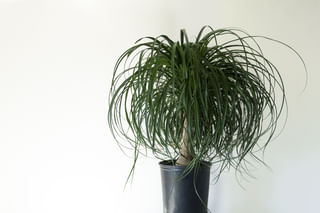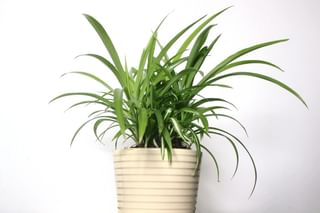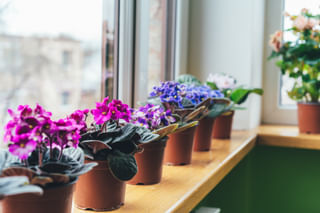The 7 best pet friendly houseplants for pet owners
In this guide, we're going to look at the best pet friendly houseplant that you can safely keep around your cats and dogs. These plants are non-toxic and recover from (accidental) damages quite quickly.
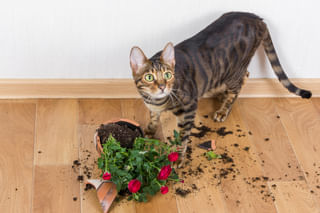
In this post, we're going to look at the best cat friendly houseplants and the best dog friendly houseplants. This is a short list of the plants we're going to look at:
- Parlor palms
- Ponytail palms
- Calatheas
- Maranta Prayer plant
- Boston fern
- Spider plants
- African Violets
All of these plants are pet friendly plants that both look great and are easy to care for in your house. Let's get started and find the best indoor plants for you to get next!
Parlor palm
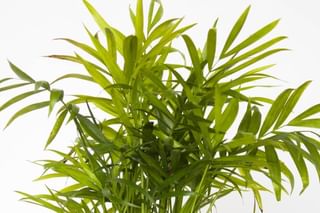
Ponytail palms
The ponytail palm is an unusual looking tree that can grow quite large if you give it the space. It's a great plant for those of us who forget to water our plants every once in a while. The Ponytail palm is one of the popular houseplants that's also used for Bonsai by some plant owners.
The Ponytail palm is a very sturdy plant that can survive a fall and is completely safe for cats and dogs. It's a plant that grows quickest when you put it in a very bright spot in your house, but it can also grow well in a spot where it doesn't get as much sunlight. With the Ponytail Palm, you have a very low-maintenance and beautiful plant that is completely safe to have around your pets. If you'd like to learn more about taking care for a Ponytail Palm, have a look at: "How to take care of a Ponytail Palm".
Calathea
Calatheas are some of the most beautiful houseplants you can get! However, they're also not the best plants for beginners: They can be very difficult to take care of. Calatheas need indirect sunlight, not too much, not too little. This helps to keep their beautiful leaves colorful and prevent sunburns on their leaves. The most difficult part of taking care of Calatheas, at least for me, is to keep their soil moist and the air around it very humid. Calatheas love humid environments and that can be quite tough to get if you live in a cold or dry climate.
Calatheas can be difficult to take care of, but they're great to have when you have cats or dogs. These plants are non-toxic and won't harm your pets if they accidentally chew on them. A Calathea can recover quickly if you give it enough humidity.
If a Calathea sounds like the right plant for you, read more about taking care of it in "How to take care of a Calathea".
Maranta Prayer Plant
The Maranta Prayer plant is called the prayer plant because it folds its leaves during the night and unfolds them again in the morning. The Prayer plant is often confused for being a Calathea, because of it's beautiful leaves and interesting patterns. This plant is not a Calathea though and is much easier to care for. It doesn't need as much humidity and is quite happy to dry out for a day before being watered again.
Like the Calathea, the Maranta prayer plant doesn't like to be in a bright spot, but also doesn't do well in a low-light place. You'll need a spot that gets medium sunlight exposure, so the leaves keep their bright colors and don't get any sunburns. The Maranta is a plant that's very easy to propagate, in case your pet accidentally destroys the plant. It's also not toxic, which makes it perfect to have around those cats and dogs that tend to chew on your plants: They won't be harmed by this wonderful plant. If this plant is something for you, read more about how to take care of it in "How to take care of a Maranta Prayer Plant".
Boston Fern

The Boston Fern is a perfect plant for those places in your house where sunlight can't reach very well. These spots are often too dark for other houseplants, but the Boston fern does well in these places. It's a plant that loves humidity and thrives when it's growing in soil that moist most of the time. A common place for the Boston Fern is a bathroom, because this space often doesn't get too much sunlight and the humidity is always quite high.
The Boston fern is a plant that grows quickly, so it can recover from damaged leaves quite quickly. It's also a non-toxic plant, so you can safely have it around your pets without having to worry about any harm done to them. The fact that this plant grows quickly, also means it can recover quickly when your cat or dog knocks it over.
If this the Boston fern sounds like the right plant for you, find out more about taking care of it in "How to take care of a Fern indoors".
Spider plant
The Spider plant is a plant that looks like grass, but grows long vines and grows many baby plants when you take great care of it. The Spider plant is a very tough plant that does well in a lot of different spaces, it can grow outdoors if you live in a warm and humid environment, but also does really well in any house. A spider plant grows best in a space where it gets indirect sunlight. Too much sunlight will turn the Spider plant a light green, and too little sunlight and the leaves will turn dark green. It's also a plant that loves to be watered all the time and is perfect for those of you who water your plants a little too often.
It's a plant that's non-toxic and recovers from any damage very quickly. It's also very easy to propagate, just in case the parent plant doesn't survive an attack from your cat or dog.
If you're interested to find out how you can take care of a spider plant, have a look at "How to take care of a spider plant".
African violets
Last, but not least, we've got the African violet! African Violets are flowers that come in different colors and grow well in those bright spots in your house. Like many other flowers, African violets need bright (filtered) light to keep their flowers bright and colorful, but also need to sit in moist soil all the time. The flower doesn't like to sit in wet soil, so you'll have to make sure you give the soil excellent drainage, but it also doesn't like to be in dry soil. This means the soil should retain water as well. You can find special African violet soil mixes, or mix your own soil with 1/3 vermiculite, 1/3 perlite, and 1/3 peat moss. This soil provides excellent drainage, while still holding onto plenty of moisture for the flower.
Like the other plants in this post, the African violet is non-toxic and perfectly safe to have around your cats and dogs. You can add color to your living spaces, without having to worry about your furry babies.
If you'd like to know more about taking care of an African violet, read "How to take care of African Violets".
Conclusion
Plants, cats, and dogs are often a tough combination to have in your house! Luckily, there are still many beautiful plants around that are completely safe to have around your furry babies. These plants will brighten your day, while you can be certain that your pets are going to be fine if they happen to eat your plants. The plants on the other hands, will be fine when they're knocked over of chewed on, because they can recover quickly and grow new leaves. Plants and pets doesn't have to be a bad combination, you just have to pick the right plants to bring into your house! I hope you've found the next plant you can bring into your house and around your pets!
Thank you for reading this post! I hope it helps you to keep your plants healthy and beautiful! If you're looking for more guides on specific plants, you can always request a plant guide to get a guide for the plant you have trouble with.
Test your plant care knowledge
Quiz completed!
Want to learn more? Sign up for my newsletter to receive free tips in your inbox!
Sign up now!